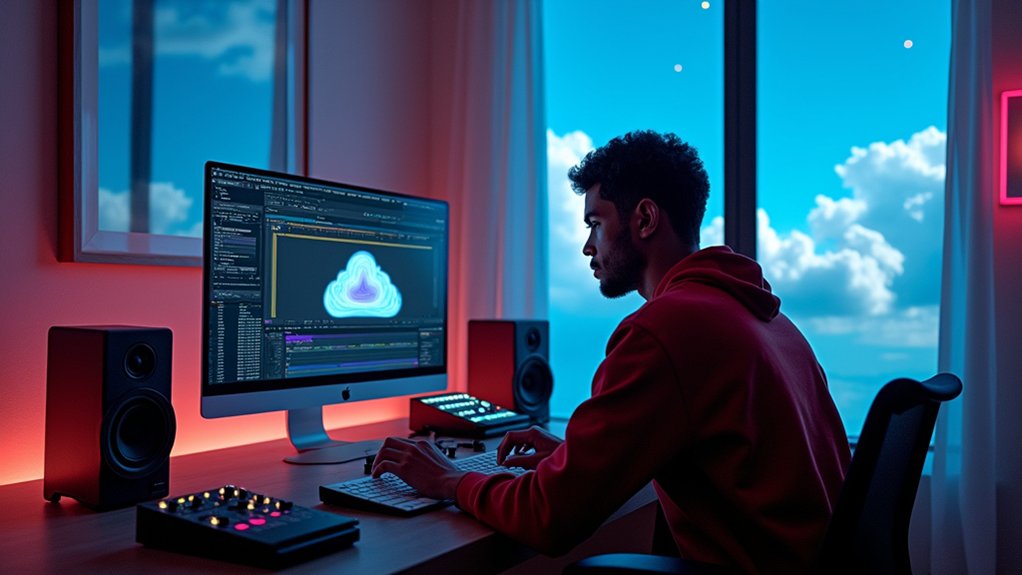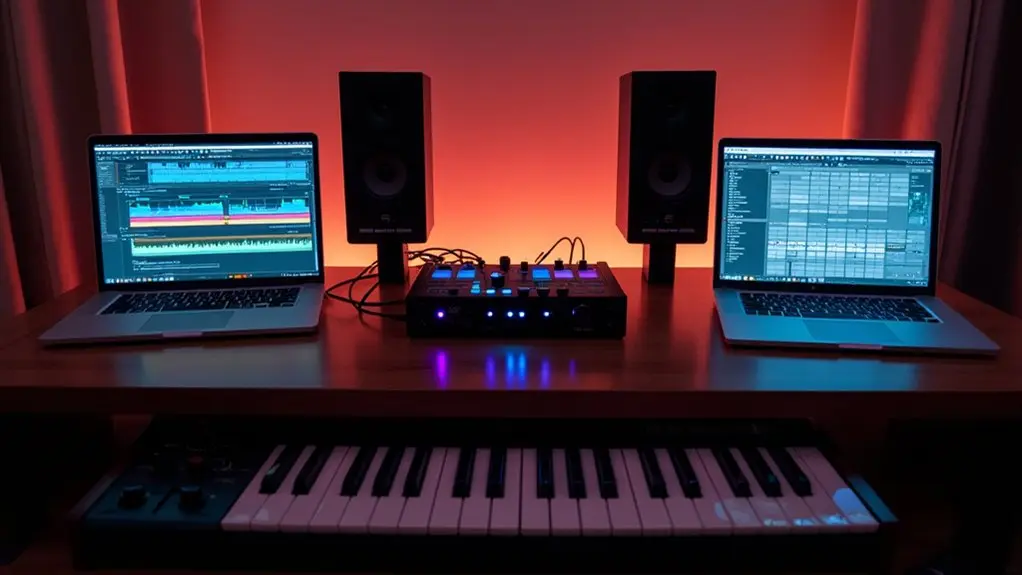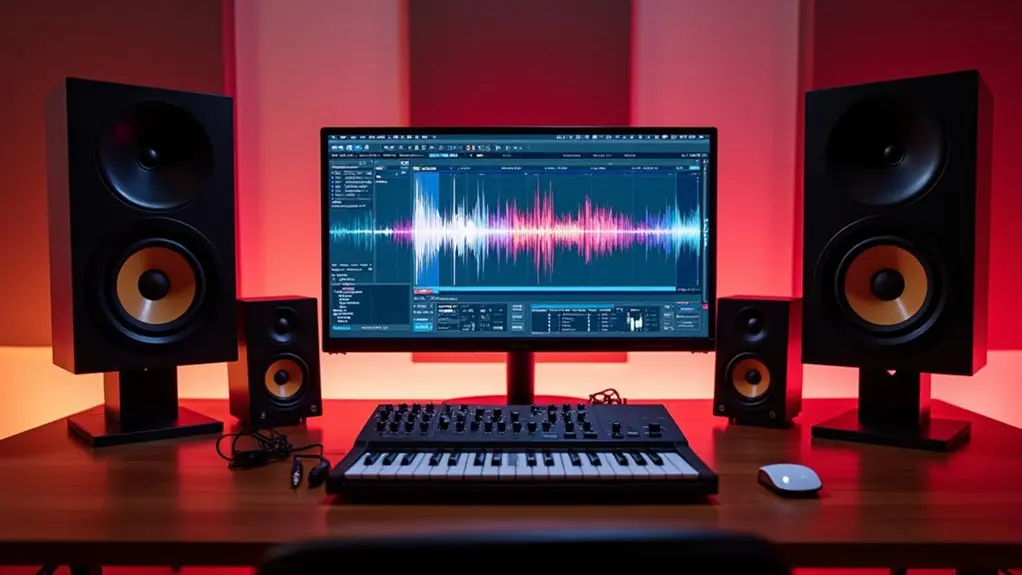Ableton Live is a DAW that emphasizes creative workflow and real-time sound manipulation, making it ideal for producers seeking experimentation and speed. Its dual-view interface, seamless integration with Ableton Push, and vast library of sounds and effects set it apart for live performance and studio work alike. A robust community supports collaboration and problem-solving. Those evaluating toolkits for dynamic, genre-spanning production will find Ableton’s unique approach compelling—the next sections reveal deeper aspects and specific advantages.
Key Takeaways
- Ableton Live’s intuitive interface and real-time sound manipulation make it ideal for creative, spontaneous music production and live performance.
- Integration with Ableton Push offers hands-on control and expressive input, bridging studio workflow and stage performance.
- The extensive sound library and Max for Live allow for deep sonic flexibility and custom device creation.
- A strong, engaged user community provides abundant tutorials, resources, and collaborative opportunities for all skill levels.
- Its dual-view workflow and streamlined design support both experimental ideas and professional arrangement, suiting diverse production needs.
Live as a Creative Instrument
While most digital audio workstations prioritize linear workflows and conventional interfaces, Ableton Live distinguishes itself by functioning as a creative instrument in its own right.
Live’s user-friendly interface removes barriers to entry, allowing instant access to tools that invite spontaneous exploration and experimentation. Its production environment is engineered for musical creativity, supporting playful engagement through features like intuitive sampling and lightning-fast audio warping.
This approach empowers users to manipulate sounds in real time, enabling unique sound design without interrupting workflow. The emphasis on making the process fun to use, rather than focusing solely on the end product, fosters an open-ended, exploratory atmosphere.
As a result, Live encourages users to pursue unconventional ideas and develop original material, redefining what a DAW can be for modern producers. Moreover, understanding the interface and navigation in Ableton Live equips users with the skills to seamlessly switch between Session View and Arrangement View, enhancing both live performances and detailed compositions.
Integration With Ableton Push and Workflow
Although digital audio workstations have long offered MIDI controllers as performance tools, the integration of Ableton Push with Live represents a significant advancement in workflow design. Push transforms music creation by providing hands-on control of Ableton’s features, seamlessly bridging Session View and Arrangement view for both live performance and studio production. Its velocity- and pressure-sensitive pads facilitate nuanced MIDI input, supporting expressive finger drumming, step sequencing, and chord creation. Immediate access to instruments, effects, and samples eliminates constant mouse navigation, streamlining the production process and enhancing creative flow. Push encourages real-time interaction and exploration, making it invaluable for producers seeking an intuitive workflow. The high-resolution display on Ableton Push 2 enhances usability by allowing precise adjustments during music production sessions. Tactile control streamlines music creation and editing. Deep integration enhances MIDI clip manipulation. Effortless navigation between Session View and Arrangement view. Expanded access to Ableton features fosters experimentation. Optimized for both live performance and studio production.
Exploring the Ableton User Community
How does a digital audio workstation transcend its software boundaries to become a catalyst for creative growth? Ableton Live achieves this through a robust user community that enhances the user experience beyond the interface itself.
The community, comprised of DJs, producers, and live event engineers, actively shares insights and supports knowledge sharing, making the music production learning curve more navigable. Accessible tutorials, workflow tips, and technical resources are abundant, especially on Ableton’s website and YouTube channel, fostering continuous skill development. Exploring Live Packs provides access to a diverse range of instruments and genres, enhancing creativity and musical expression within the community.
Collaboration within this community not only accelerates problem-solving but also sparks creative approaches to production. For both newcomers and seasoned users, participation in the Ableton Live community transforms solitary learning into a collective endeavor, offering rich resources and collaborative opportunities to refine one’s craft.
Sound Library and Sonic Flexibility
Beyond the collaborative momentum fostered by the Ableton user community, the breadth and depth of Ableton Live 12’s sound library play a pivotal role in shaping workflow and creative output.
The Suite edition offers over 5000 expertly crafted sounds, instruments, and effects, supporting sonic flexibility across genres. The continually evolving library—bolstered by both Ableton and third-party sound packs—ensures users have access to innovative tools for creative sound manipulation. Max for Live further enhances these possibilities by enabling custom device creation, expanding beyond built-in capabilities. Enhanced browser features, including advanced tags and filters, streamline the search for sounds, optimizing workflow and facilitating creative exploration. The Magnetic Lo-Fi Sample Pack combines analog warmth with digital creativity, making it an excellent choice for producers seeking rich, nostalgic sounds.
- Diverse sound library supports any genre
- Professional-grade instruments and effects included
- Max for Live enables custom sound design
- Enhanced browser speeds up sound discovery
- Continuous expansion via new packs and updates
Rethinking Music Production With Ableton Live
Ableton Live transforms the traditional approach to music production through its innovative dual-view interface, empowering users to fluidly alternate between Session and Arrangement views for seamless idea development and real-time experimentation.
This workflow-centric design enables music producers to capture, manipulate, and refine sound and music with unparalleled flexibility, whether recording and editing audio or implementing MIDI controllers such as Ableton Push for advanced step sequencing and expressive performance.
The integration of high-quality sounds, instruments, and effects, along with continuous updates introducing new features, guarantees a rich creative workflow adaptable to any genre.
Additionally, Live’s emphasis on playful exploration streamlines audio processing and fosters collaboration through a vibrant community, abundant tutorials, and resource sharing, making it an industry-standard environment for innovative music production.
For beginners, mastering EQ and compression is essential for creating a balanced and professional sound, providing a solid foundation to build upon as they progress in their music production journey.
Frequently Asked Questions
Is Ableton Live the Best DAW?
Determining if Ableton Live is the best DAW depends on user priorities; its Ableton features, workflow efficiency, robust MIDI capabilities, versatile sound library, intuitive user interface, audio effects, and genre versatility excel, though the learning curve varies for music production and live performance.
Is There a Difference Between Ableton and Ableton Live?
The distinction lies in terminology: “Ableton” refers to the company, while “Ableton Live” is its flagship DAW. Live capabilities include unique workflow, instruments, effects, performance tools, ongoing updates, tutorials, community engagement, and streamlined collaborations.
What’s Better Than Ableton Live?
Determining what’s better than Ableton Live depends on workflow needs; FL Studio, Logic Pro, Cubase Pro, Studio One, Reason Studios, Pro Tools, GarageBand alternatives, Bitwig Studio, and Reaper features offer unique digital audio environments and creative advantages.
Which DAW Is Best Overall?
Determining the best overall DAW requires a DAW comparison chart factoring user friendly interfaces, genre specific features, robust audio editing tools, advanced MIDI capabilities, extensive plugin support options, pricing models comparison, community support resources, and thorough learning curve analysis.
Conclusion
Ableton Live stands out as a DAW that merges technical capability with creative flexibility, making it a compelling choice for producers seeking an intuitive workflow. Its deep integration with Push, robust sound library, and active user community support innovative music creation and performance. While workflow preferences vary, Live’s session view and real-time manipulation tools encourage experimentation and rapid idea development, positioning it as a forward-thinking platform for artists aiming to rethink their production process.




